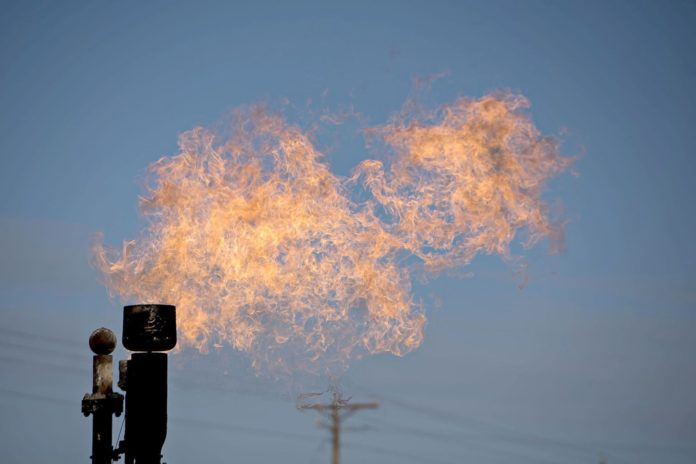LONDON — When OPEC started a price war last November, driving oil down to its current $65 a barrel, U.S. shale drillers looked doomed. Six months later, it’s the world’s largest oil companies that are emerging as the unexpected casualties.
The reason: the multibillion-dollar projects at the heart of the oil majors’ strategy need prices closer to $100 to make them economically feasible.
“Big Oil is today squeezed by two low-cost producers: OPEC and U.S. shale,” said Michele Della Vigna, the top oil industry analyst at Goldman Sachs Group Inc. “Big Oil needs to re-invent itself.”
The new period of cheap oil and ample supplies raises a prospect unthinkable as recently as a few months ago — that the world no longer needs all the big, expensive projects planned by companies such as Royal Dutch Shell, Chevron and Total SA.
Rising supplies from Saudi Arabia, Iraq and perhaps Iran combined with a more efficient shale industry could deliver the bulk of new production. Big Oil will continue to play a significant role, particularly as field developments sanctioned in the era of $100 a barrel come to fruition — but new projects will suffer.
Oil company CEOs including Exxon Mobil’s Rex Tillerson and BP’s Bob Dudley are meeting with OPEC ministers Wednesday and Thursday in Vienna at a biannual conference organized by the cartel.
Only six months ago, the industry’s thinking was very different. The view then was that shale firms could only survive with $100 oil. The expected wave of bankruptcies never came about, however, and shale output has continued growing as drillers cut costs in response to low prices.
Ryan Lance, CEO of ConocoPhillips, said in Vienna on Wednesday that the industry now accepted that the U.S. shale drillers were far more resilient than expected.
“They are reducing the cost and restoring the margins that we enjoy at $80 to $90 to get those at $60 to $70,” Lance said in an interview. “That is how resilient the opportunity set is.”
Meanwhile, the majors’ problems, which were masked by high oil prices, have become clear: bespoke developments are too expensive and their complexity means they’re unlikely to benefit from a drop in costs as much as simpler shale wells. In addition, those megaprojects can’t be turned on and off like shale drilling can, preventing quick response to any price recovery.
Jim Chanos, founder of hedge fund Kynikos Associates, is among the loudest voices warning about an industry that has bet its future on complex projects that is effectively “replacing $20 oil with $80 oil.”
While smaller companies have held costs of finding and developing new fields steady in the past five years at $14.47 a barrel, major producers have seen them almost double from 2010 levels to $29.95 a barrel, according to Citigroup Inc. data, as they focus on oil sands, gigantic liquefied natural gas developments and deep-water projects.
Big Oil companies say their strategy is sound. For one, vast refining operations provide them with an extra cash stream and they’re dominant in the growing LNG industry.
Tillerson last week said that Exxon’s integrated business, including its large chemicals unit, was “a competitive advantage that is not easily replicated.”
They also have some potential lifeboats to jump in: Mexico’s oil industry is opening to foreign investors for the first time in nearly 80 years, Brazil is likely to seek more international partners, and Iran offers the promise of welcoming overseas groups again.
“It’s not just big oil companies, the whole industry is going to have to adjust,” BP’s Dudley said in an interview in Paris on Tuesday. “I don’t feel we’re getting crushed. It’s a widespread change.”
Shell CEO Ben van Beurden agreed to buy BG Group Plc for $70 billion, betting oil prices are going to get back to at least $90 a barrel by 2018. The company is also involved in an expensive drilling campaign in the Arctic and is planning several multibillion-dollar gas projects.
Most Big Oil companies struggle at $75 a barrel, said Alastair Syme, an oil analyst at Citigroup. “In the pursuit of growth in recent years, we think many companies have not left enough headroom to deal with a lower oil price environment,” he said.
In the first quarter, Total, BP and Chevron all spent more than they earned. The combined negative cash flow of the five major oil groups was $3.4 billion, compared with a positive cash flow of $17.8 billion a year earlier, according to data compiled by Bloomberg.
If that’s sustained, the companies would either have to reduce their investments further or take on loans to pay their dividends.
“We have reduced capex from headline levels, but in terms of projects, we haven’t stopped any,” Shell Chief Financial Officer Simon Henry said. “The opportunity for us over the next three to four years is to take the costs down and be more selective about new investments.”
— With assistance from Rakteem Katakey and Firat Kayakiran in London.






